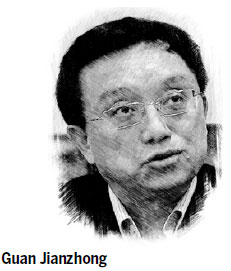A credit rating service with a difference
By Ed Zhang (China Daily) Updated: 2015-07-04 09:35
Guan Jianzhong, CEO of Dagong Global Credit Rating Co, says he had a passion for high theories when he was young. Since the 2008 global financial crisis he has, apart from managing his company with 700-strong staff, spent most of his time studying how the prevalent credit rating practices were partly to blame for the crisis and looking for alternatives. On the sidelines of the June 29-30 World Credit Rating Forum in Beijing, Guan answered questions raised by China Daily's senior writer Ed Zhang about what Guan called innovative general methodology in credit rating and the basic ideas behind it.
Q: How is Dagong different from the world's other credit rating services?
A: Our main difference comes from the very fundamental theory of our credit rating operations. For most other credit rating companies, the key elements are default and the probability of default. But as I see it, a study of a debtor's past record of credit doesn't necessarily explain his or her future risk of default. If it's a company, the rating that you get is far from the whole picture, and you still don't know how sound its business is and if it is going through some important changes now.
The methodology in their calculation of default rate tends to also contain factors that don't have direct relations with a company's debt service capability.
Q: But if default and default rate are taken away from the consideration, what else can be used to measure a debtor's credit-worthiness?
A: My focus is not on taking away that concept or on finding the extent to which its weight should be reduced. My focus is on an alternative, or rather the financial source of the debtor to pay back the debt. Debt is not a problem so long as a debtor is secured with adequate sources of debt service or repayment. The source of repayment reflects the debtor's wealth-generating capability. The stronger a debtor's wealth-generating capability, the higher rating level it deserves.

I’ve lived in China for quite a considerable time including my graduate school years, travelled and worked in a few cities and still choose my destination taking into consideration the density of smog or PM2.5 particulate matter in the region.











